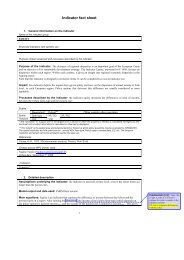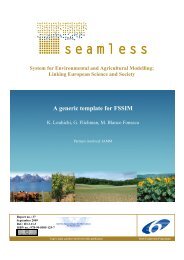Farming Systems Design 2007 - International Environmental ...
Farming Systems Design 2007 - International Environmental ...
Farming Systems Design 2007 - International Environmental ...
Create successful ePaper yourself
Turn your PDF publications into a flip-book with our unique Google optimized e-Paper software.
<strong>Farming</strong> <strong>Systems</strong> <strong>Design</strong> <strong>2007</strong><br />
Field-farm scale design and improvement<br />
CRITICAL REFLECTION ON MODELLING SUPPORT IN LAND-USE<br />
DECISION-MAKING<br />
P. Carberry 1 , W. Rossing 2 , B. Sterk 3 , M. Howden 1<br />
1<br />
CSIRO Agricultural Sustainability Initiative, Australia, peter.carberry@csiro.au; mark.howden@csiro.au<br />
2<br />
Biological <strong>Farming</strong> <strong>Systems</strong>, Wageningen Uni and Research, The Netherlands, walter.rossing@wur.nl<br />
3<br />
Plant Production <strong>Systems</strong>, Wageningen Uni and Research, The Netherlands, barbara.sterk@wur.nl<br />
Introduction<br />
Over the past 30 years, there has been a consistent rationale to justify much of the research<br />
undertaken in the field of agricultural systems analysis. Such rationale proposes that decisionmakers,<br />
whether farmers, policy-makers, or other stakeholders, struggle with the complexity and<br />
uncertainty inherent in agricultural systems and would welcome access to technologies which<br />
lessen this burden. Consequently, it is argued that the management of land, whether at the field,<br />
farm or regional scale, can benefit from science knowledge and models. However, the adoption by<br />
farmer and policy clients of Decision Support <strong>Systems</strong> (DSS) derived from science models has<br />
been a disappointment to many developers and a number of assumptions underpinning this<br />
rationale have been challenged and solutions proposed (van Ittersum et al., 1998; McCown et al.,<br />
2002; Parker et al., 2002; Walker, 2002; Rossing et al., <strong>2007</strong>).<br />
A brief foray into the literature reveals that the nexus between science and policy is a field of<br />
significant study and that the troubled relationship between science-based decision support and<br />
political decision-making in agricultural land use is more often the typical situation than not at the<br />
broader science-policy interface (Hoppe, 2005). The objective of this paper is to try to discern<br />
possible intervention approaches using systems models into the agricultural policy domain.<br />
Different science intervention models for POR<br />
A number of approaches can be identified as having been employed by researchers in agricultural<br />
land use studies in engaging in policy-oriented research using their systems modelling tools.<br />
Based on the work of Hoppe (2001) we have represented these approaches as five diagrammatic<br />
models based around the interface between two spheres representing the science sphere<br />
occupied by researchers and the policy domains staffed by analysts and advisers (Figure 1). Type<br />
A symbolizes the likely traditional status quo in agriculture land use studies whereby science<br />
operates within its own sphere, aimed at creating knowledge and tools, whilst policy operates in a<br />
separate sphere with analysts (many science trained) generating policy advice for political<br />
decision-makers. The link between the two is via the large arrow, signifying that analysts go<br />
looking for knowledge and tools from the science sphere on a needs basis and bring what they<br />
want back into their sphere for use.<br />
The history of development of agricultural decision support systems has largely operated with<br />
scientists designing and developing DSS tools for expected use by decision makers, either at the<br />
farm or policy scale. Type B represents a common, though maybe extreme view of DSS tools<br />
developed in the science sphere and passed over to decision-makers (dotted arrow) with<br />
expectations of uptake. Relative to the investment in tool and methodology development, little<br />
effort is usually placed in fostering such adoption or evaluating impacts. Types A and B are modes<br />
of operation that largely maintain divergence between the science and policy spheres and much of<br />
the past efforts in agricultural systems analysis can be readily categorised to fall within such<br />
schema. However, governments and research funders are increasingly demanding more costeffective<br />
outcomes from shrinking public-good funding for research. We can identify three<br />
additional models whereby science intervention in the policy sphere has been attempted using<br />
systems analysis tools in land management studies.<br />
We all know of prominent scientists who have become embroiled within the political sphere. They<br />
have not simply engaged with politicians, they have worked to become part of the political<br />
establishment and in doing so have been able to have science heard in political debates. Type C<br />
- 2 -




